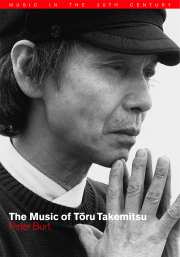Book contents
- Frontmatter
- Contents
- Acknowledgements
- Note on conventions
- Introduction
- 1 Pre-history: how Western music came to Japan
- 2 Music and ‘pre-music’: Takemitsu's early years
- 3 Experimental workshop: the years of Jikken Kōbō
- 4 The Requiem and its reception
- 5 Projections on to a Western mirror
- 6 ‘Cage shock’ and after
- 7 Projections on to an Eastern mirror
- 8 Modernist apogee: the early 1970s
- 9 Descent into the pentagonal garden
- 10 Towards the sea of tonality: the works of the 1980s
- 11 Beyond the far calls: the final years
- 12 Swimming in the ocean that has no West or East
- Notes
- List of Takemitsu's Works
- Select bibliography
- Index
4 - The Requiem and its reception
Published online by Cambridge University Press: 18 August 2009
- Frontmatter
- Contents
- Acknowledgements
- Note on conventions
- Introduction
- 1 Pre-history: how Western music came to Japan
- 2 Music and ‘pre-music’: Takemitsu's early years
- 3 Experimental workshop: the years of Jikken Kōbō
- 4 The Requiem and its reception
- 5 Projections on to a Western mirror
- 6 ‘Cage shock’ and after
- 7 Projections on to an Eastern mirror
- 8 Modernist apogee: the early 1970s
- 9 Descent into the pentagonal garden
- 10 Towards the sea of tonality: the works of the 1980s
- 11 Beyond the far calls: the final years
- 12 Swimming in the ocean that has no West or East
- Notes
- List of Takemitsu's Works
- Select bibliography
- Index
Summary
Two years after the death of Hayasaka, Takemitsu himself was obliged to take to his sickbed, and it was in this incapacitated state that he worked on a commission he had received from the Tōkyō Symphony Orchestra, sometimes managing to complete only a single bar, or even half a bar, during the course of a day. The work that eventually emerged from these painstaking efforts, Requiem for Strings, received its first performance in June 1957, and the composer's comments at the time certainly gave the impression that this intensely elegiac work was intended as a memorial to his departed mentor: while Takemitsu claimed he had not written the piece ‘grieving over the death of any specific person’, as he was writing it he ‘gradually came to think about Fumio Hayasaka, and mourn his passing’.
In subsequent years, however, Takemitsu was to give a slightly fuller account of the Requiem's genesis, and hint at the presence of a second possible dedicatee. In one of his many conversations with Takashi Tachibana, for instance, he observed that ‘at that time especially I was seriously ill, and since I finally realised that I didn't know when I myself was going to die, I ended up thinking that one way or another I'd like to create one piece before my death … I thought I ought to write my own requiem’. This later version of events, in which the composer himself becomes the object of déploration, is corroborated by remarks made by Takemitsu in other contexts.
- Type
- Chapter
- Information
- The Music of Toru Takemitsu , pp. 50 - 72Publisher: Cambridge University PressPrint publication year: 2001

